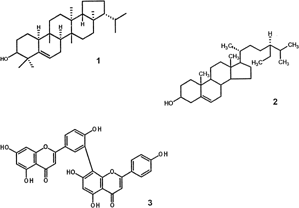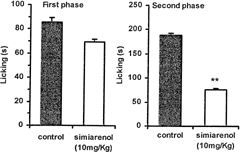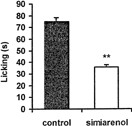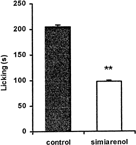Abstract
In the current study, we investigated the analgesic activity of a crude methanol extract and some fractions obtained from Hyeronima alchorneoides Allemao leaves and analyzed its phytochemical profile to determine active principles. All the fractions exhibited analgesic properties using the writhing test in mice, but the hexane fraction was the most active, causing 96.4 ± 1.0% inhibition at 10 mg/kg. Three compounds were isolated and identified based on their spectral data: simiarenol (1), β.-sitosterol (2), and amentoflavone (3). Compound 1, a rare terpene isolated for the first time from the family Euphorbiaceae, presented a calculated ID50 value of 18.87 (14.6–24.4)µmol/kg with the writhing test, being about 8-fold more active than two known analgesic and anti-inflammatory drugs (aspirin and dipyrone). In the formalin test, it was particularly active against the second phase, with inhibition of 59.5 ± 9%, suggesting a peripheral activity. In the capsaicin and glutamate tests, it showed inhibition of 52.3 ± 4 and 52.1 ± 6%, respectively.
Introduction
Hyeronima alchorneoides. Allemao (Euphorbiaceae) belongs to one of the largest families, which has about 290 genera and 7500 species. This family is spread all over the world, mainly in tropical areas of South American and African countries. In Brazil, this plant grows from north to south, along the coastal rain forest. In Santa Catarina, south of Brazil, they are known as margonçalo. or lucurana. (Lorenzi, Citation1998). A decoction of its bark is used as an antitussive agent by North American people (Tinto et al., Citation1991).
Just a few phytochemical studies on this plant have been found in the literature. In this context, Tinto and co-workers (Citation1991) reported two new compounds from its roots (hyeronimone and its acetate), besides a rare butenolide (aquilegiolide), along with other three well-known compounds from the leaves, identified as lupeol, stigmasterol, and β-sitosterol. Later, Buske and co-workers (Citation2002) isolated another compound from this plant, named antidesmone, and showed its chemotaxonomic importance. To our best knowledge, no pharmacological investigation has been reported of this plant until now.
In this study, we have investigated the chemical composition of Hyeronima alchorneoides. leaves and verified its possible analgesic effects against some pharmacological models of pain in mice.
Materials and Methods
Phytochemical analysis
Plant material
Leaves from Hyeronima alchorneoides. were collected in Morro do Baú (Ilhota), State of Santa Catarina, Brazil, during spring 1999. The plant material was identified by Dr. Ademir Reis (Department of Botany, UFSC, Florianópolis). A voucher specimen was deposited at Barbosa Rodrigues Herbarium, Itajaí (VC Filho 020).
Isolation and identification of compounds
Dried leaves (685 g) of H. alchorneoides. were ground and macerated with methanol for 10 days at room temperature. The solution was filtered and concentrated (reduced pressure) to 100 ml. The extract was successively partitioned with n.-hexane, dichloromethane, and ethyl acetate. Then, each solvent was evaporated to dryness (under reduced pressure), yielding 15.1, 0.74, and 6.6 g of the respective fractions.
Part of the n.-hexane fraction (5.0 g) was chromatographed on a silica gel column eluted with a n.-hexane:ethyl acetate gradient. After monitoring by thin-layer chromatography (TLC), fractions were combined and rechromatographed as described above. This methodology afforded two solid white compounds, which were identified as simiarenol (1) (57 mg) and β.-sitosterol (2) (33 mg) (Scheme ). Compound 1 was identified by spectroscopic data (IR, 1H NMR and 13C NMR) and comparison with literature data (Heupel, Citation1985; Chakravarty et al., Citation1994). Compound 2 was identified by spectroscopic data and direct comparison with an authentic sample.
The ethyl acetate fraction (3.0 g) was purified by reverse-phase HPLC (LiChrosfer 100 RP-18, 250 × 20 mm, 10-µm particle size) under isocratic conditions with 70% acetonitrile in water, acclimated to 30°C. This fraction furnished one pure compound, identified as amentoflavone (3) (40 mg) (Scheme ), which was identified by spectroscopy data (IR, 1H NMR and 13C NMR), being identical to those reported in the literature (Dora & Edwards, Citation1991).
Pharmacological analysis
Animals
Male Swiss mice (25–35 g), housed at 22 ± 2°C under a 12-h light/12-h dark cycle and with access to food and water ad libitum., were used. Experiments were performed during the light phase of the cycle. Animals were acclimatized to the laboratory for at least 2 h before testing and were used once throughout the experiments. All experiments reported in this study were carried out in accordance with current guidelines for the care of laboratory animals and ethical guidelines for investigation of experimental pain in conscious animals (Zimmermann, Citation1983).
Drugs
The following substances were used: acetic acid, formalin, L-glutamic acid, and capsaicin (Calbiochen, San Diego, CA, USA). The extracts and compound isolated from H. alchorneoides. leaves as well as reference drugs were dissolved in DMSO or Tween 80 (E. Merck), plus 0.9% of NaCl solution, with the exception of glutamate which was prepared in phosphate buffer saline (PBS, composition mmol/L: NaCl 137, KCl 2.7 and phosphate buffer 10) and capsaicin which was dissolved in ethanol. The final concentration of DMSO, Tween 80 and ethanol did not exceed 57% and did not cause any effect ‘per se.’.
Methods
Acetic acid–induced writhing
The abdominal constriction was induced in mice by intraperitoneal injection of acetic acid (0.6%), as described by Collier et al. (Citation1968) with a few modifications (Campos et al., Citation2002). Animals were pretreated intraperitoneally 30 min before with the extracts (10 mg/kg) and compound isolated (10, 6, and 3 mg/kg) from H. alchorneoides. leaves. Control animals received a similar volume of saline solution (10 ml/kg). The number of abdominal constrictions (full extension of both hind paws) was cumulatively counted over a period of 20 min. Antinociceptive activity was expressed as the reduction of the number of abdominal constrictions between control animals and mice pretreated with the extracts or compound studied.
Formalin test
The observation chamber was a glass cylinder of 20-cm diameter with a mirror at 45° to allow clear observation of the paws of the animals. The mice were treated with 0.9% saline solution (i.p.) or simiarenol (10 mg/kg, i.p.) 30 min before formalin injection. Each animal was placed in the chamber for 5 min before treatment in order to allow acclimatization to the new environment. The formalin test was carried out as described by Hunskaar and Hole (Citation1987) with a few modifications (Campos et al., 2002). Twenty microliters of a 2.5% formalin solution (0.92% formaldehyde) in 0.9% saline solution were injected intraplantarly in the right hind paw. The animal was then returned to the chamber and the amount of time that it spent licking the injected paw (registered in seconds) was considered as indicative of pain. Two distinct phases of intensive licking activity were identified: an early acute phase and a late or tonic phase (0–5 and 15–30 min after formalin injection, respectively).
Capsaicin-induced nociception
In an attempt to provide more direct evidence concerning its possible antinociceptive effect on neurogenic nociception, simiarenol was investigated in capsaicin-induced licking in the mouse paw. The procedure used was similar to that previously described (Sakurada et al., Citation1992). After the adaptation period, 20 μl of capsaicin (1.6 μg/paw) was injected intraplantarly in the right hind-paw. Animals were observed individually for 5 min after capsaicin injection. The amount of time spent licking the injected paw was timed with a chronometer and was considered as indicative of nociception. Animals were treated with simiarenol i.p. (10 mg/kg) 30 min before capsaicin injection. Control animals received a similar volume of saline solution intraperitoneally.
Glutamate-induced nociception
Animals were treated with simiarenol via i.p. (10 mg/kg) 30 min before glutamate injection. A volume of 20 μl of glutamate solution (30 μmol/paw), made up in phosphate-buffered saline (PBS), was injected intraplantarly under the surface of the right hind-paw as previously described (Beirith et al., Citation2002). After injection of glutamate, the animals were individually placed into glass cylinders of 20 cm in diameter and observed from 0 to 15 min. The time spent licking and biting the injected paw was timed with a chronometer and considered as indicative of pain.
Statistical analysis
The results are presented as mean ± SEM, except the ID values (i.e., the dose of simiarenol reducing the nociceptive response by 50% in relation to control value), which are reported as geometric means accompanied by their respective 95% confidence limits. The ID50 value was determined by linear regression from individual experiments using linear regression GraphPad software (GraphPad software, San Diego, CA, USA). The statistical significance of differences between groups was detected by analysis of variance (ANOVA) followed by Dunnett's multiple comparison test. p values less than 0.05 (p > 0.05) were considered as indicative of significance.
Results
Effects of crude methanolic extract, fractions and simiarenol from H. alchorneoides. leaves on acetic acid–induced writhing
The extracts exhibited marked reduction in the number of abdominal constrictions induced by the injection of aqueous solution of acetic acid. As can be observed in , all the extracts were more active than the non steroidal anti-inflammatory and analgesic drugs, used here for the purpose of comparison. The compound isolated from the most active fraction, simiarenol (1), produced potent and dose-dependent analgesic action with an ID50 value (and 95% of confidence limits) of 18.87 (14.6–24.4) µmol/kg (), whereas aspirin and paracetamol presented ID50 values of 133 (73.0–247.0) µmol/kg and 125 (140.0–250.0) µmol/kg, respectively.
Figure 1Effect of the simiarenol (7.0, 14.1, and 23.4 µmol/kg, i.p.), isolated from the hexane fraction of H. alchorneoides. leaves, against acetic acid–induced pain in mice. Each column represents mean ± SEM of six experimental values. **p < 0.01.
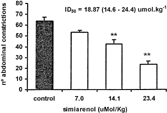
Table 1 Comparison of antinociceptive effect of the extracts from H. alchorneoides. leaves with nonsteroidal anti-inflammatory and analgesic drugs given intraperitoneally to mice.
Effect of simiarenol isolated from hexane fraction of H. alchorneoides. leaves on the formalin-induced pain test
Simiarenol inhibited both phases of the formalin test showing a pain inhibition of 18.6 ± 7% in the early phase (0–10 min) and 59.5 ± 9% in the late phase (15–30 min), being, therefore, more effective against the late phase of formalin test ().
Effect of simiarenol isolated from hexane fraction of H. alchorneoides. leaves on capsaicin and glutamate tests
The results indicated in show that simiarenol promoted a significant inhibition (52.3% ± 4) of chemical-induced pain, when analyzed in the capsaicin-induced neurogenic nociception. shows that simiarenol (10 mg/kg) given by i.p. route significantly inhibited glutamate-induced biting responses in mice by 52.1 ± 6%.
Discussion
The methanolic extract obtained from H. alchorneoides. leaves significantly decreased the number of acetic acid–induced abdominal constrictions in mice when compared to control (), with an inhibition percentage of 55.9% ± 3.7. This extract was then subjected to successive liquid partition with different solvents with increasing polarity (n.-hexane, dichloromethane, and ethyl acetate). Although all these three fractions showed a considerable activity when tested in the writhing test using 10 mg/kg (about 90% inhibition), hexane and ethyl acetate fractions were studied in more detail, because the dichloromethane fraction showed a very low yield, and its TLC profile showed great similarity with the hexane fraction. The hexane fraction exhibited a better analgesic profile () with the writhing test. Although this test is considered a nonspecific model (e.g., anticholinergic and antihistaminic and other agents show activity in this test), it is widely used for analgesic screening and involves local peritoneal receptors (cholinergic and histamine receptor) and the mediators of acetylcholine and histamine (Calixto et al., Citation2000; Choi et al., Citation2003).
Part of the hexane fraction was then chromatographed by conventional methods, yielding two compounds, identified as simiarenol (1) and β.-sitosterol (2) based on their spectral data. β.-Sitosterol (2) consists of a well-documented phytosterol distributed broadly among higher plants. This compound was previously tested as analgesic causing inhibition of 54% with the writhing test at 10 mg/kg (Santos et al., Citation1995) and, for this reason, it was not included in this study. Simiarenol (1) is a rare pentacyclic triterpene, containing a hopano nucleus, being here reported for the first time in the family Euphorbiaceae.
Of great interest of this study is the demonstration, for the first time, that simiarenol (1) possesses pronounced antinociceptive activity in all the models tested. In the acetic acid–induced abdominal constriction test, it presented a calculated ID50 value of 18.87 (14.6–24.4)µmol/kg, being several times more active than some reference drugs, like aspirin and dipyrone, two well-known analgesic and anti-inflammatory drugs, which presented ID50 values of 133 and 162 µmol/kg, respectively, in the same experimental model (Navarro et al., Citation2002).
Subcutaneous injection of formalin produces distinct biphasic pain, called early and late phases. Drugs that act primarily on the central nervous system inhibit both phases equally, whereas peripherally acting drugs inhibit the late phase (Shibata et al., Citation1989). The ability of simiarenol to inhibit significantly only the second phase of the formalin test suggests that peripheral mechanisms are involved.
Another interesting result was the action of simiarenol in inhibiting capsaicin-induced stimulation of primary afferents. The data obtained in the current study showed that simiarenol reduced the licking/biting response to intraplantar capsaicin, which provided more direct evidence of the analgesic effect of this compound on neurogenic pain. It is important to mention that some well-known nonsteroidal anti-inflammatory drugs, including aspirin and paracetamol, are ineffective or exhibit weak activity in the first phase of the formalin test and in the capsaicin model, but they significantly inhibit the second phase of the formalin-induced licking (Navarro et al., Citation2002).
To corroborate with the peripheral antinociception, simiarenol (1) was analyzed in the glutamate-induced model. In this model of nociception, glutamate apparently acts through peripheral receptors via interaction with N-methyl-D-aspartate (NMDA) and non-NMDA receptors by a mechanism that depends on the activation of the L-arginine–nitric oxide pathway (Scheidt et al., Citation2002). The results showed that simiarenol reduced the licking/biting response to intraplantar glutamate indicating that it acts through the excitatory amino acid glutamate, exerting a relevant peripheral role in controlling nociceptive processes. The most polar fraction, ethyl acetate, also exhibited good analgesic effects, which is related, at least in part, to the presence of the flavonoid amentoflavone (3). It was recently isolated by us from another plant, Calophyllum brasiliense. (Camb.) leaves, showing an interesting analgesic profile in mice (Silva et al., Citation2001).
In conclusion, the results of the current study demonstrated that the extract and fractions obtained from Hyeronima alchorneoides. leaves exert a marked antinociceptive effect in the acetic acid–induced writhing test, being more effective than some nonsteroidal anti-inflammatory and analgesic drugs given intraperitoneally in mice. The main active principle, simiarenol (1) is a rare compound with promising analgesic properties, and additional studies are in progress to elucidate its probable mechanism of action.
Acknowledgments
The authors are grateful to Prof. Dr. Ademir Reis for collection and classification of the plant material. This work was supported by grants from CNPq, FUNCITEC-SC, and ProPPEC/UNIVALI, Brazil.
References
- Beirith A, Santos ARS, Calixto JB (2002): Mechanisms underlying the nociception and paw oedema caused by injection of glutamate into the mouse paw. Brain Res 924: 219–228. [PUBMED], [INFOTRIEVE], [CSA]
- Buske A, Schimidt J, Hoffmann P (2002): Chemotaxonomy of the tribe Antidesmeae (Euphoribiaceae): Antidesmone and related compounds. Phytochemistry 60: 489–496. [PUBMED], [INFOTRIEVE], [CROSSREF], [CSA]
- Calixto JB, Beirith A, Ferreira J, Santos AR, Cechinel-Filho V, Yunes RA (2000): Naturally occurring antinociceptive substances from plants. Phytother Res 14: 401–418. [PUBMED], [INFOTRIEVE], [CROSSREF], [CSA]
- Campos F, Corrêa R, De Souza MM, Yunes RA, Nunes RJ, Cechinel-Filho V (2002): Studies on new cyclic imides obtained from aminophenazone with analgesic properties. Drug Res 52: 455–461. [CSA]
- Chakravarty AK, Masuda K, Suzuki H, Ageta H (1994): Unambiguous assignment of 13C chemical shifts of some hopane and migrated hopane derivatives by 2D NMR. Tetrahedron 50: 2865–2876. [CROSSREF], [CSA]
- Choi J, Lee KT, Ha J, Yun SY, Ko CD, Jung HJ, Park HJ (2003): Antinociceptive and anti-inflammatory effects of Niga-ichigoside F1 and 23-hydroxytormentic acid obtained from Rubus coreanus.. Biol Pharm Bull 10: 1436–1441. [CROSSREF], [CSA]
- Collier HDJ, Dinnin LC, Johnson CA, Schneider C (1968): The abdominal response and its suppression by analgesic drugs in the mouse. Br J Pharmacol 32: 295–310. [CSA]
- Dora G, Edwards JM (1991): Taxonomic status of Lanaria lanata. and isolation of a novel biflavone. J Nat Prod 54: 796–801. [CROSSREF], [CSA]
- Heupel RC (1985): Varietal similarities and differences in the polycyclic isopentenoid composition of sorghum. Phytochemistry 24: 2929–2937. [CROSSREF], [CSA]
- Hunskaar AT, Hole K (1987): The formalin test in mice: Dissociation between inflammatory and non-inflammatory pain. Pain 30: 103–104. [PUBMED], [INFOTRIEVE], [CROSSREF], [CSA]
- Lorenzi H (1998): Árvores Brasileiras: Manual de Identificação e Cultivo de Plantas Arbóreas Nativas de do Brasil, 2nd ed. Nova Odessa, São Paulo, Editora Plantarum.
- Navarro DF, De Souza MM, Neto RA, Golin V, Niero R, Yunes RA, Delle Monache F, Cechinel Filho V (2002): Phytochemical analysis and analgesic properties of Curcuma zedoaria. grown in Brazil. Phytomedicine 9: 427–432. [CROSSREF], [CSA]
- Sakurada T, Katsumata K, Tan-No K, Sakurada S, Kisara K (1992): The capsaicin test in mice for evaluating tachykinin antagonists in the spinal cord. Neuropharmacology 31: 1279–1285. [PUBMED], [INFOTRIEVE], [CROSSREF], [CSA]
- Santos ARS, Niero R, Cechinel-Filho V, Yunes RA, Pizzolatti MG, Delle Monache F, Calixto JB (1995): Antinociceptive properties of steroids from Phyllanthus corcovadensis. in mice. Planta Med 61: 329–332. [PUBMED], [INFOTRIEVE], [CSA]
- Scheidt C, Santos ARS, Ferreira J, Malheiros A, Cechinel-Filho V, Yunes RA, Calixto JB (2002): Evidence for the involvement of glutamatergic receptors in the antinociception caused in mice by the sesquiterpene drimanial. Neuropharmacology 43: 340–347. [PUBMED], [INFOTRIEVE], [CROSSREF], [CSA]
- Shibata M, Ohkubo T, Takahashi H, Inoki R (1989): Modified formalin tests: Characteristic biphasic pain response. Pain 38: 347–352. [PUBMED], [INFOTRIEVE], [CROSSREF], [CSA]
- Silva KL, Santos ARS, Mattos PE, Yunes RA, Delle-Monache F, Cechinel-Filho V (2001): Chemical composition and analgesic activity of Calophyllum brasiliense. leaves. Therapie 56: 431–434. [PUBMED], [INFOTRIEVE], [CSA]
- Tinto WF, Blynden G, Reynolds WF, McLean S (1991): Constituents of Hyeronima alchorneoides.. J Nat Prod 54: 1309–1313. [CROSSREF], [CSA]
- Zimmermann M (1983): Ethical guidelines for investigations of experimental pain in conscious animals. Pain 16: 109–110. [PUBMED], [INFOTRIEVE], [CROSSREF], [CSA]
